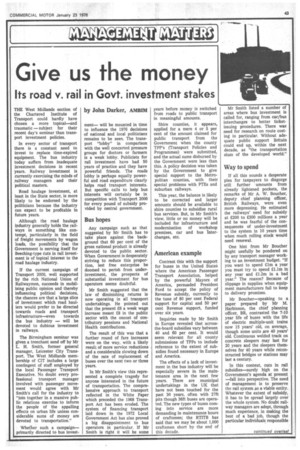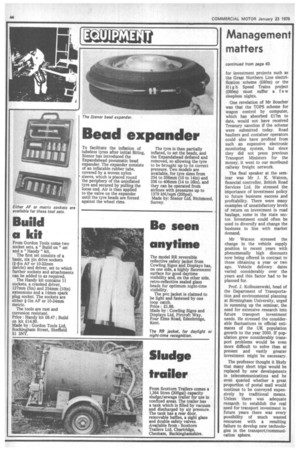Give us the money
Page 45

Page 46

If you've noticed an error in this article please click here to report it so we can fix it.
Its road v. rail in Govt. investment stakes
by John Darker, AMBIM THE West Midlands section of the Chartered Institute of Transport could hardly have chosen a more topical—and traumatic — subject for their recent day's seminar than transport investment policies.
In every sector of transport there is a constant need to invest to replace time-expired equipment. The bus industry today suffers from inadequate investment decisions in recent years. Railway investment is currently exercising the minds of railway managers and their political masters.
Road haulage investment, at least in the State sector, is more likely to be endorsed by the politicians because the industry can expect to be profitable in future years.
Although the road haulage industry generally holds the railways in something like contempt, particularly in the field of freight movements by wagon loads, the possibility that the Government is nerving itself for Beeching-type cuts in rail investment is of topical interest to the road haulage industry.
If the current campaign of Transport 2000, well supported by the rich National Union of Railwaymen, succeeds in mobilising public opinion and thereby influencing political decisions, the chances are that a large slice of investment which road hauliers would prefer to be directed towards roads and transport infrastructure—even towards the bus industry — will be devoted to dubious investment in railways.
The Birmingham seminar was given a trenchant send off by Mr L. H. Smith, former general manager, Leicester City Transport. The West Midlands membership of CIT includes a large contingent of staff employed by the local Passenger Transport Executive. No doubt every professional transport manager involved with passenger movement would agree with Mr Smith's call for the industry to "join together in a massive public relations exercise to inform the people of the appalling effects on urban life unless considerable sums of money are devoted to transportation."
Whether such a campaign— primarily directed to bus invest ment— will be mounted in time to influence the 1976 decisions of national and local politicians remains to be seen. The transport "lobby" in comparison with the well concerted pressure groups for doctors or farmers is a weak lobby. Publicists for rail investment have had 50 years of practice and they have powerful friends. The roads lobby is perhaps equally powerful and road expenditure clearly helps road transport interests. But specific calls to help bus interests will certainly be in competition with Transport 2000 for every pound of subsidy provided by central government.
Bus hopes
Any campaign such as that suggested by Mr Smith has to take place against the background that 60 per cent of the gross national product is already devoted to the public sector. When Government is desperately striving to reduce this proportion, lest free enterprise be doomed to perish from underinvestment, the prospects of substantial investment for bus operators seems doubtful.
Mr Smith suggested that the law of diminishing returns is now operating in all transport undertakings. He pointed out that the present £6 a week wage increase meant £8 in the public sector with the oncost of contributory pensions and National Health contributions.
The result of this was that a further round of fare increases were on the way, with a likely result of more service reductions and a considerable slowing down of the rate of replacement of buses over the next two or three years.
In Mr Smith's view this represented a complete tragedy for anyone interested in the future of transportation. The comprehensive approach to transport reflected in the White Paper which preceded the 1968 Transport Act has been eroded. The system of financing transport laid down in the 1972 Local Government Act has also proved a big disappointment to bus operators in particular. If Mr Smith is right it will be some years before money is switched from roads to public transport in meaningful amounts.
Shire counties, it appears, applied for a mere 4 or 5 per cent of the amount claimed for public transport from the Government when the county TPP's (Transport Policies and Programmes) were submitted, and the actual sums disbursed by the Government were less than this. A policy decision was taken by the Government to give special support to the Metropolitan counties, with their special problems with PTEs and suburban railways.
This year, the balance is likely to be corrected and larger amounts should be available to shire counties to subsidise rural bus services. But, in Mr Smith's view, little or no money will be included for infrastructure and modernisation of workshop premises, car and bus Interchanges, etc.
American example
Contrast this with the support for buses in the United States where the American Passenger Transport Association, helped by the powerful Mayors of America, persuaded President Ford to accept the policy of Revenue subsidy, currently to the tune of 80 per cent Federal support for capital and 50 per cent Revenue support, funded over six years.
Inquiries made by Mr Smith in Europe revealed that acrossthe-board subsidies vary between 40 and 60 per cent. It would seem relevant for all county submissions of TPPs to include reference to the extent of subsidies found necessary in Europe and America.
The effects of a lack of investment in the bus industry will be especially severe in the maintenance area in the next few years. There are municipal undertakings in the UK that have not been touched for the past 30 years, often with 27ft pits though 36ft buses are operated. The new types of buses coming into service are more demanding in maintenance hours of craftsmen; the RTITB has said that we may be about 1,000 craftsmen short by the end of this decade. Mr Smith listed a number of areas where bus investment is called for, ranging from car/bus interchanges to better ticketissuing procedures. There was need for research on route costing in particular. Without adequate public support Britain could end up, within the next decade, as "the transportation slum of the developed world."
Way to spend
If all this sounds a desperate plea for taxpayers to disgorge still further amounts from already lightened pockets, the remarks of Mr A. W. Boucher, deputy chief planning officer, British Railways, were even more depressing. He estimated the railways' need for subsidy at £200 to £300 millions a year and he was fearful of the consequences of under-investment to the system in 10 years time when much rolling stock would need renewal.
One hint from Mr Boucher might usefully be pondered on by any transport manager working to an investment budget. 'If you want to spend Elm a year you must try to spend £1.1m in any year and £1.2m in a bad year." The reason? Because of slippage in supplies when equipment manufacturers fail to keep to delivery promises.
Mr Boucher—speaking to a paper prepared by Mr M. Harbinson, the chief planning officer, BR, contrasted the 7-10 year life of buses with the life of electric multiple-unit trains now 15 years' old, on average, though some units are 40 years' old. Continuous welded track on concrete sleepers may last for 20 years and the sleepers themselves for 40 years while reconstructed bridges or stations may last a century.
In this context, cuts in rail subsidies—surely high on the Government's agenda at present —fall into perspective. The need of management is to preserve the rail system as a viable entity. Whatever the extent of subsidy, it has to be spread largely over the whole system. No doubt railway managers are adept, through much experience, in making the best of a bad job, though the particular individuals responsible for investment projects such as the Great Northern Line electrification scheme (£80m) or the High Speed Trains project (£60m) must suffer a few sleepless nights.
One revelation of Mr Boucher was that the TOPS scheme for wagon control by computer, which has absorbed £17m to date, would not have received Treasury sanction if the scheme were submitted today. Road hauliers and container operators could also have profited from such an expensive electronic monitoring system, but since they did not press previous Transport Ministers for the money, it went to our moribund railway freight network.
The final speaker at the seminar was Mr J. K. Watson, financial controller, British Road Services Ltd. He stressed the importance of investment policy to future business success and profitability. There were many examples of unsatisfactory levels of return on investment in road haulage, some in the state sector. Investment could often be used to diversify and change the business in line with market demand.
Mr Watson stressed the change in the vehicle supply position in recent years with phenomenally high discounts now being offered in contrast to those obtaining a year or two ago. Vehicle delivery dates varied considerably over the years and this factor had to be planned for.
Prof. J. Kolbuszewski, head of the Department of Transportation and environmental planning at Birmingham University, urged in summing up the seminar, the need for extensive research into future transport investment needs. He stressed the considerable fluctuations in official estimates of the UK population growth to the year 2000. If population grew considerably transport problems would be even more difficult to solve than at present and vastly greater investment might be necessary.
The professor thought it likely that many short trips would be replaced by new developments in telecommunications and he even queried whether a great proportion of postal mail would continue to be conveyed expensively by traditional means. Unless there was adequate research to establish the real need for transport investment in future years there was every possibility of much wasted resources with a resulting failure to develop new technologies in the transport/communication sphere.
















































































